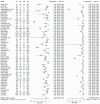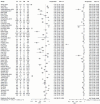Diagnostic Accuracy of Deep Learning for Intracranial Hemorrhage Detection in Non-Contrast Brain CT Scans: A Systematic Review and Meta-Analysis
- PMID: 40217828
- PMCID: PMC11989428
- DOI: 10.3390/jcm14072377
Diagnostic Accuracy of Deep Learning for Intracranial Hemorrhage Detection in Non-Contrast Brain CT Scans: A Systematic Review and Meta-Analysis
Abstract
Background: Intracranial hemorrhage (ICH) is a life-threatening medical condition that needs early detection and treatment. In this systematic review and meta-analysis, we aimed to update our knowledge of the performance of deep learning (DL) models in detecting ICH on non-contrast computed tomography (NCCT). Methods: The study protocol was registered with PROSPERO (CRD420250654071). PubMed/MEDLINE and Google Scholar databases and the reference section of included studies were searched for eligible studies. The risk of bias in the included studies was assessed using the QUADAS-2 tool. Required data was collected to calculate pooled sensitivity, specificity, positive predictive value (PPV), and negative predictive value (NPV) with the corresponding 95% CI using the random effects model. Results: Seventy-three studies were included in our qualitative synthesis, and fifty-eight studies were selected for our meta-analysis. A pooled sensitivity of 0.92 (95% CI 0.90-0.94) and a pooled specificity of 0.94 (95% CI 0.92-0.95) were achieved. Pooled PPV was 0.84 (95% CI 0.78-0.89) and pooled NPV was 0.97 (95% CI 0.96-0.98). A bivariate model showed a pooled AUC of 0.96 (95% CI 0.95-0.97). Conclusions: This meta-analysis demonstrates that DL performs well in detecting ICH from NCCTs, highlighting a promising potential for the use of AI tools in various practice settings. More prospective studies are needed to confirm the potential clinical benefit of implementing DL-based tools and reveal the limitations of such tools for automated ICH detection and their impact on clinical workflow and outcomes of patients.
Keywords: ICH; NCCT; artificial intelligence; deep learning; intracranial hemorrhage; non-contrast computed tomography.
Conflict of interest statement
The authors declare no conflicts of interest.
Figures










Similar articles
-
Diagnostic Accuracy of Cone-Beam CT for Acute Intracranial Hemorrhage: A Systematic Review and Meta-Analysis.J Am Coll Radiol. 2024 Dec;21(12):1841-1850. doi: 10.1016/j.jacr.2024.07.026. Epub 2024 Aug 13. J Am Coll Radiol. 2024. PMID: 39147252
-
Prognostic value of CT scan-based radiomics in intracerebral hemorrhage patients: A systematic review and meta-analysis.Eur J Radiol. 2024 Sep;178:111652. doi: 10.1016/j.ejrad.2024.111652. Epub 2024 Jul 26. Eur J Radiol. 2024. PMID: 39079323
-
Prospective Evaluation of Artificial Intelligence Triage of Intracranial Hemorrhage on Noncontrast Head CT Examinations.AJR Am J Roentgenol. 2024 Nov;223(5):e2431639. doi: 10.2214/AJR.24.31639. Epub 2024 Sep 4. AJR Am J Roentgenol. 2024. PMID: 39230402
-
Diagnostic Accuracy of Artificial Intelligence Compared to Biopsy in Detecting Early Oral Squamous Cell Carcinoma: A Systematic Review and Meta Analysis.Asian Pac J Cancer Prev. 2024 Aug 1;25(8):2593-2603. doi: 10.31557/APJCP.2024.25.8.2593. Asian Pac J Cancer Prev. 2024. PMID: 39205556 Free PMC article.
-
Artificial intelligence in antimicrobial stewardship: a systematic review and meta-analysis of predictive performance and diagnostic accuracy.Eur J Clin Microbiol Infect Dis. 2025 Mar;44(3):463-513. doi: 10.1007/s10096-024-05027-y. Epub 2025 Jan 6. Eur J Clin Microbiol Infect Dis. 2025. PMID: 39757287
Cited by
-
Artificial intelligence for detecting traumatic intracranial haemorrhage with CT: A workflow-oriented implementation.Neuroradiol J. 2025 Jun 3:19714009251346477. doi: 10.1177/19714009251346477. Online ahead of print. Neuroradiol J. 2025. PMID: 40458857 Free PMC article.
References
-
- Fernando S.M., Qureshi D., Talarico R., Tanuseputro P., Dowlatshahi D., Sood M.M., Smith E.E., Hill M.D., McCredie V.A., Scales D.C., et al. Intracerebral Hemorrhage Incidence, Mortality, and Association with Oral Anticoagulation Use. Stroke. 2021;52:1673–1681. doi: 10.1161/STROKEAHA.120.032550. - DOI - PubMed
-
- Woo D., Comeau M.E., Venema S.U., Anderson C.D., Flaherty M., Testai F., Kittner S., Frankel M., James M.L., Sung G., et al. Risk Factors Associated with Mortality and Neurologic Disability After Intracerebral Hemorrhage in a Racially and Ethnically Diverse Cohort. JAMA Netw. Open. 2022;5:e221103. doi: 10.1001/jamanetworkopen.2022.1103. - DOI - PMC - PubMed
Publication types
LinkOut - more resources
Full Text Sources

